Typically, when discussing Australian housing, the narrative goes along these lines: “Yes, our house prices are some of the most expensive in the world, but we have strong migration, good affordability and limited supply compared with other countries, which justifies the high prices.”
Under ‘normal’ conditions, the argument holds water, but in the current climate it becomes questionable. This article looks at the bigger picture indicators -unemployment, immigration, fiscal support and interest rates - to glean the potential direction of the housing market.
1. Unemployment
The largest risk to the property market at the moment comes from unemployment. While the official unemployment statistics can show some noise, due to how those who have lost their job are classified, the statistic of the percentage of the working age population that is employed shows how drastic this change has been. Around 3.5% of the working-age population have lost their jobs since March, which does not include those who are currently on the JobKeeper programme (~3 million people). This is a decline of close to 700,000 jobs and is two times larger than in the early 1990s recession and four times larger than the 2008 recession.
Chart 1: Employment to population change
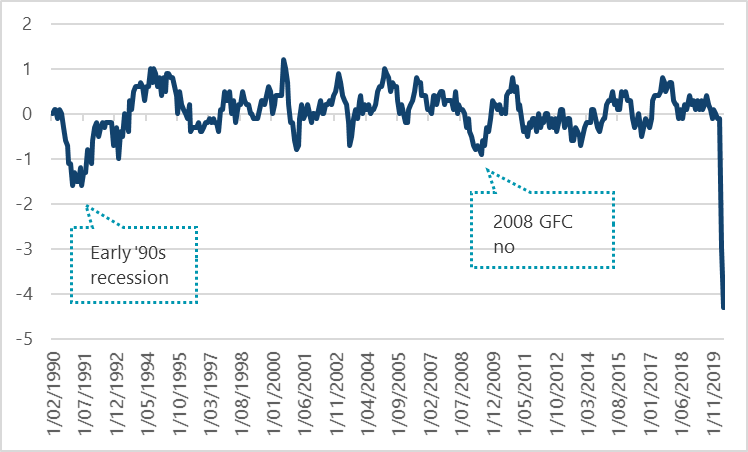
Source: Bloomberg
While the economic damage was bad globally in 2009, it was muted in Australia as we avoided the worst of the fallout, registering only a benign slowdown in employment.
This huge level of unemployment in 2020 has brought with it economic hardship that has required relief from the banking system. The Australian Banking Association has said that almost 500,000 borrowers have been granted loan deferrals, with The Australian Financial Review stating that about one in five of these ”are in deep financial strife”. Australian Prudential Regulation Authority (APRA) states that deferrals across home loans account for about 10% of all loans.
The problem that this unemployment situation creates is two-fold.
Firstly, APRA announced in July that it would extend the deferral process for another six months, until March 2021, but that the temporary capital measures given to the banks can only be applied:
“Where the ADI has undertaken an appropriate credit assessment of the borrower and is satisfied that they have a reasonable prospect of being able to repay the loan … when the repayment deferral period ends”.
APRA additionally stated that “in some cases, banks will need to recognise that loans are permanently impaired”.
There is a risk that some loans become impaired in September, as a more complete picture of the potential for employment outcomes will be known. If a sizeable amount of those one in five who are in deep financial strife are deemed not able to repay, then there could be tens of thousands of forced sellers hitting the market in the back end of this year.
While we do not expect this is the most likely outcome, as the new deferrals shift this risk to March 2021, CoreLogic statistics show that over the past two years about 30,000 to 40,000 properties sell each month in Australia. This means these borrowers alone could account for three months’ worth of volume, coming at a time when volumes have been lower than usual.
Secondly, with 700,000 Australians having lost their job and another 3 million facing some uncertainty with how long JobKeeper will run, it’s hard to envision who will be stepping up to buy properties that are sold by those in financial distress. If the unemployment problem persists longer than the market currently expects, which is a distinct possibility now that Victoria has shut down Melbourne and Sydney COVID-19 cases are rising (at the time of writing), there will be pressure for prices to move lower. Australia has not faced a situation like this for almost 30 years. The only way this can be spun as a positive is that APRA is buying time for a recovery to take hold, yet even then household leverage will only be rising through this time.
2. Fiscal stimulus
The current iteration of the government’s higher-than-usual unemployment benefits were recently rolled for an additional six months, but with lower benefits. This will be important for the housing market.
Currently in Australia, there are two forms of stimulus to provide everyday Australian’s with support: JobKeeper and JobSeeker. These programmes provide $1,500 and $1,115 a fortnight respectively, which is almost two to three times higher than the previous $500-$600 Newstart payments and are set to reduce to $1,200 and $815 respectively in October.
In Australia, the average mortgage balance is $400,000, which on a 30-year term with 3% interest would cost about $780 per fortnight. The bare minimum living expense for a person in Sydney, as calculated using an example lenders Household Expenditure Measure (HEM) is $546 per fortnight.
We can compare how the typical household would fare living with an average mortgage using an estimate of the different government benefits:

Source: Australian Government, Nikko AM, home loan experts. *HEM living expenses used the lowest income estimate for the Sydney area, assuming no dependants. This is likely an underestimate of the true cost of living for the average person.
The shaded boxes in the table show the current forecast financial position. While certainly not ideal, a single person on JobKeeper may just be able to cover their mortgage and bare minimum living expenses. For couples on JobSeeker or JobKeeper, the fortnightly income covers a typical mortgage and the minimum living expenses, although this would not look anywhere near as healthy when using the ABS average household expenditure (excluding housing) of around $2,300 per fortnight.
This highlights just how important the increased spending from the Australian government has been for enabling households to continue meeting their minimum living expenses.
Compare this to the outcome in October, when the payments are reduced, shown on the right-hand side of the table. The typical household will start experiencing financial stress, especially those on JobSeeker, as the $815 payment for a single person would only just cover the typical fortnightly mortgage payment, without accounting for any other living expenses.
This analysis also holds true for Australians who are renting, paying on average $872 per fortnight. Should these people be unable to afford rent, property investor income will be jeopardised and the demand for housing will fall.
The numbers and potential for financial distress are startling, without even accounting for the fact that unemployment benefits are set to fall even further in January. The financial bill that the government will incur if these policies continue means that we should now expect them to slowly be wound back, setting up a worrying outlook as stimulus declines.
3. Immigration and population growth
Over the past five years, the Australian population has been increasing by approximately 350,000 people per year, with roughly 220,000 of those coming from overseas. Given the borders are expected to be shut until 2021, immigration will be weak for at least the next six months—moving population growth closer to the natural increase of 140,000 people, a reduction of ~60% vs a normal year.
Since the average Australian household has 2.6 people living in it, this will be a reduction in demand of around 80,000 properties per year while the borders remain closed.
Chart 2: Australian population growth
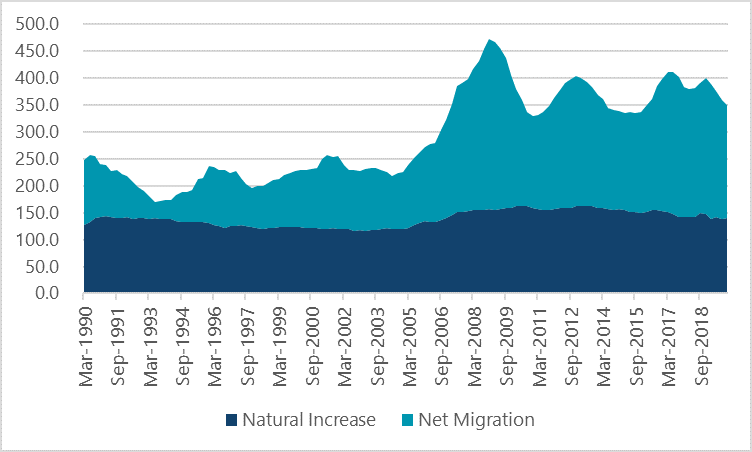
Source: Australian Bureau of Statistics
Over the past five years, rising house prices and lower interest rates have encouraged higher levels of building, with the number of new dwellings increasing by around 2% per annum. As Chart 3 shows, new dwelling stock was running well above population growth for the past few years. The supply was so large in 2019 that there were constant fears of oversupply in new apartments. This year, that narrative is likely to be exacerbated as population growth is set to fall to around 0.5% (one third of its prior levels), much lower than the 1% growth seen through the late ’90s, creating a picture of oversupply.
Chart 3: Population and dwelling stock growth* (year ended)
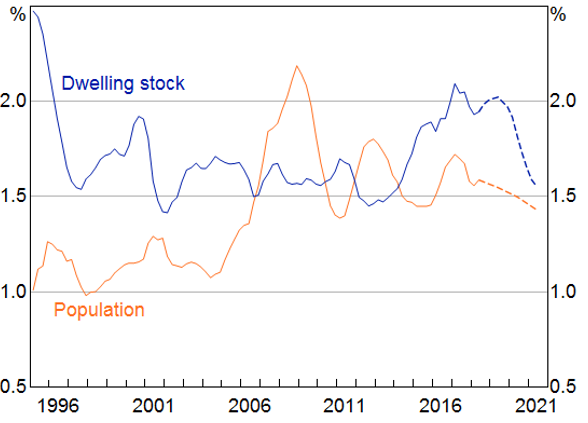
Source: Reserve Bank of Australia (Mar 2019). *Dotted lines represent forecasts.
This should lead to a weakening in mortgage approvals, particularly for investors, as it will be harder to have certainty around the investment implications of a property. Rents will be weaker than usual and with no international tourism, short-term stay properties have been locking in tenants leading to greater supply in the rental market.
Overall, this is one of the more concerning big picture issues over the next 12 months. A traditional source of demand from population growth will be slowing at a time when unemployment is high and the ability for Australians to buy housing is lower than usual.
4. Interest rates
Interest rates have consistently fallen whenever the housing market showed any signs of stress. Chart 4 shows the months with negative house price changes against the cash rate. In 2008, 2011, 2015 and 2019, the house price declines stopped as the cash rate fell. This has been no different over the past few months, with the cash rate falling 0.5% this year. Unfortunately, the Reserve Bank has little room to continue easing via traditional methods.
The strategy of cutting rates to keep prices rising looks like it could be coming to an end.
Chart 4: Australian house price index
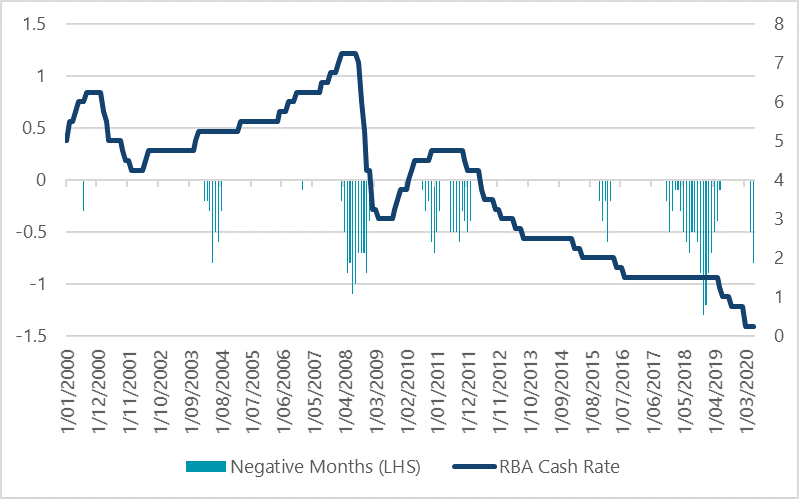
Source: Bloomberg, CoreLogic, Nikko AM
A simple measure to see the effects of interest rates on house prices is to determine how the average borrowing size will be affected by falling mortgage rates. In Australia, the average household income is $1,652 per week, which equates to roughly $1,250 after tax. Assuming a person spends 40% of their post-tax income on mortgage repayments, this gives them the ability to service about $500 per week. Here is the borrowing capacity under different interest rates on a 30-year loan, assuming the borrower pays $500 per week:
Chart 5: Borrowing capacity at different mortgage rates
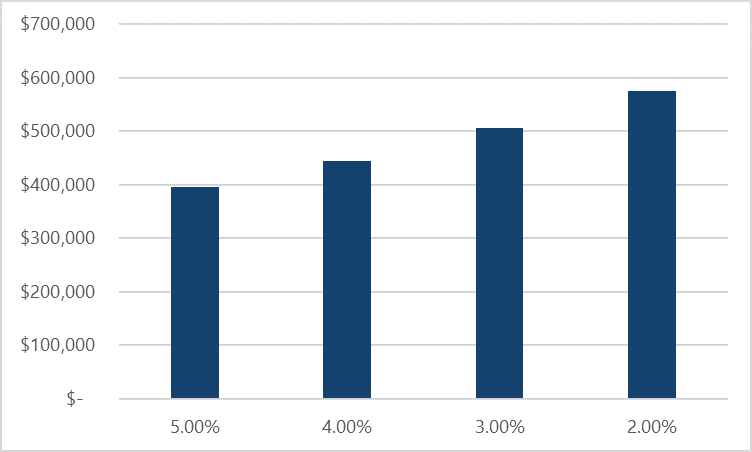
Source: Australian Bureau of Statistics, MoneySmart.gov, NikkoAM
A 1% reduction in interest rates would lead to about a 14% increase in borrowing capacity at current levels. As rates have fallen by 0.5% since the pandemic began, this would imply that the average household could take on about $30,000 more debt this year. Assuming of course, that they have not lost their employment.
While the recent rate cuts are a positive driver for the housing market, there is a looming question of whether it will be enough to offset the other negatives described above. The RBA would want to cut more if they could, but given interest rates have hit the zero lower bound, they are reluctant to provide the normal amount of easing that would be required in these circumstances.
Where does that leave us?
Overall, these big-picture drivers can be split into three broad categories - the ‘good’, the ‘bad’ and ‘it depends’.
The category of the good is the swift action taken from the Reserve Bank. With interest rates falling a little over 1% over the past 12 months, housing became more affordable. If all else were equal (note: all else is not equal) then prices would be set to rise over 15% from their mid-2019 levels. This action will help stave off some of the negative outcomes.
The category of the bad is the high unemployment and drop in immigration. Given Australia has some of the highest household debt and house price-to-income ratios in the world, it does raise questions about where the demand will come from.
The category of it depends is related to both the fiscal support and loan deferrals. At the moment, unemployment benefits are two to three times higher than they usually would be and close to 500,000 borrowers have had their payments deferred. However, many are receiving less income than is required to meet minimum living standards.
How worried should we be based on these big-picture issues? The answer to this question falls on government support and how long it will last.
There is good reason to believe that the negatives will continue to outweigh the positives over the next 12 months as the expansionary polices are slowly unwound. This means house prices could fall further than the forecast 5–10% that most expect over the short term and into the 10–20% decline range. That certainly calls for more concern than the short-term indicators would suggest.
The short-term analysis is included in the previous article.
Chris Rands is Portfolio Manager, Fixed Income at Nikko AM Limited. The information contained in this material is of a general nature only and does not constitute personal advice, nor does it constitute an offer of any financial product. Figures, charts, opinions and other data, including statistics, in this material are current as at the date of publication, unless stated otherwise. This is not a recommendation in relation to any named securities or sectors and no warranty or guarantee is provided.
The full paper can be viewed here.